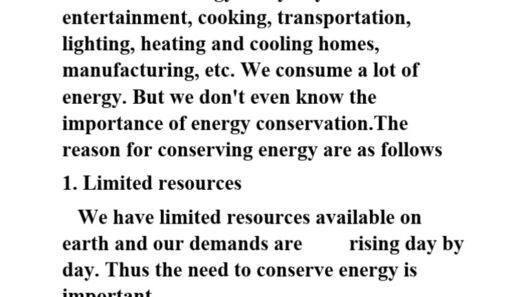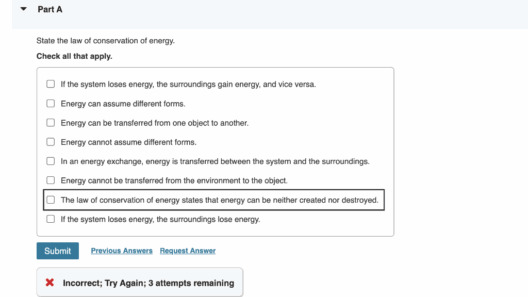The relationship between mass and energy conservation is a pivotal concept in physics, influencing a plethora of real-world applications and mathematical theories. The principle of conservation of energy states that energy cannot be created or destroyed; rather, it can only be transformed from one form to another. However, the mass of an object plays a significant role in how energy is conserved and transferred in various physical systems. This exploration will delve deeply into the intersections of mass and energy conservation, examining pivotal concepts, contextual applications, and fundamental implications.
The Conceptual Framework of Energy Conservation
Understanding the implications of mass on energy conservation begins with the foundational principles of physics. Energy exists in myriad forms — kinetic, potential, thermal, and more — and each of these forms can be influenced by the mass of an object. Kinetic energy, for instance, is expressed by the equation KE = 1/2 mv², where ‘m’ is mass and ‘v’ is velocity. This equation illuminates how increasing the mass of a moving object directly raises its kinetic energy, assuming velocity remains constant.
On a broader scale, the law of conservation of energy posits that the total energy in a closed system must remain constant. Thus, if an object with a larger mass converts its energy into kinetic energy during a fall, it will manifest a greater energy output upon impact compared to a lighter object. These disparities underscore the necessity of cognition regarding mass when analyzing energy transfers in physical phenomena.
Mass, Energy, and the Evolution of Systems
When mass is situated within dynamic systems, its role in energy conservation becomes more pronounced. Take, for instance, the concept of potential energy in gravitational fields. Potential energy is determined by the mass of an object, the gravitational acceleration, and the height of the object above a reference point, articulated as PE = mgh. Hence, two objects of varying mass at the same elevation will have distinctly different potential energy values.
This difference becomes manifest in conservation scenarios, such as roller coasters or pendulums. In a roller coaster, at the apex, the mass contributes significantly to its potential energy, which is converted to kinetic energy as the coaster plummets downwards. In this instance, regardless of the mass, the system’s total energy remains conserved. But the higher the mass, the more energy one can harness throughout the descent, facilitating thrilling momentum and velocity.
Mass and its Impact on Energy Transfer
Notably, mass affects how energy is transferred within and across systems. In collisions, for instance, the conservation of momentum plays a crucial role. The masses of the colliding objects will determine how energy is distributed post-impact. A heavy object colliding with a lighter object typically transfers energy differently compared to a collision involving similarly sized objects. Thus, understanding mass is essential for granular analyses of energetic interactions.
Consider the practical implications evident in transportation. In vehicles, the relationship between mass, energy consumption, and efficiency is crucial. Heavier vehicles, with greater mass, require more energy to initiate motion and maintain speed. Consequently, they often consume more fuel, emphasizing the importance of mass considerations in engineering, design, and sustainability efforts.
Mass, Energy, and Thermodynamics
Furthermore, the link between mass and thermal energy cannot be understated. Heat transfer is fundamentally a function of mass and the specific heat capacity of materials. Larger masses can store more thermal energy, which is a critical concept in climate science and renewable energy technologies. For instance, thermal mass is exploited in passive solar heating designs, where materials with high mass absorb and store heat energy, regulating temperature fluctuations.
This interplay between mass and thermal energy conservation has profound implications for optimizing energy systems. As society seeks sustainable solutions to energy consumption, understanding the mass-energy relationship can bolster innovative designs and technologies that minimize waste and enhance efficiency.
The Role of Mass in Energy Solutions
In conclusion, the relationship between mass and energy conservation is a multifaceted topic, deeply intertwined with various scientific principles. From the kinematics of moving bodies to thermodynamic principles in environmental systems, mass is a critical factor in determining how energy is conserved and utilized. Understanding this relationship enables scientists and engineers to develop more effective, sustainable energy solutions.
Addressing the challenges posed by climate change and energy scarcity necessitates a comprehensive grasp of these dynamics. By leveraging our understanding of mass-based energy calculations, society can innovate creative strategies to maximize energy efficiency, sustain environmental integrity, and pave the way for a sustainable future. The intricate dance between mass and energy conservation exemplifies the elegance of physics and its relevance to real-world implications, affecting everything from individual choices to global policy. By blending theory with practical application, we can envision a world where energy is not merely consumed but responsibly conserved and transformed.








